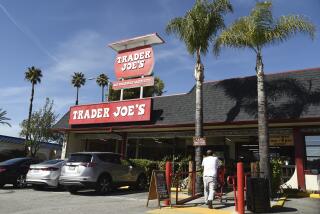Op-Ed: Before you eat that chocolate Easter egg, think about the people who produced it
Just after Valentine’s Day, prices for cocoa plummeted. Days later, media outlets erupted in a collective hurrah. “Your chocolate is getting cheaper,” headlines proclaimed. “Easter will be sweet.” What wasn’t factored into the celebration is the deep suffering of the subsistence farmers who grow cacao, the seeds of a pod-shaped fruit that, once harvested, become the cocoa traded on the commodities market and destined for the chocolate eggs and bunnies that fill most Easter baskets.
Cacao’s origins trace to the rainforests of the upper Amazon, and the seeds are believed to have been transformed into a drink in Mesoamerica at least as early as 400 BC. Once used as medicine, currency and a stand-in for human blood during rituals, today cacao — cocoa — is dried, fermented and roasted to become the foundation of the $100-billion chocolate industry. The trees grow in a tropical band 20 degrees north and south of the equator, with 70% of production based in West Africa and centered in Ivory Coast.
Despite the success of the chocolate (and confection) industries, 90% of cocoa farmers operate at the margins. A recent study by the French Development Agency and Barry Callebaut (the world’s largest cocoa manufacturer) determined farmers in Ivory Coast earn roughly 91 cents a day. Imagine what it means for those farmers when the price they receive for the fruits of their labor drops — as it has recently — by 33%.
This decline in commodity cocoa prices over the past year is the result of several factors, including predictions that consumers in China and India would develop an insatiable appetite for chocolate. Consumption has increased in these countries but not at forecasted levels. And globally, demand has remained largely unchanged. But farmers haven’t been able to slow production: They had already planted more trees in anticipation of increased demand and that, coupled with good weather in most of Ivory Coast’s cocoa-growing regions, bolstered the harvest and has resulted in a bumper crop and oversupply.
To support cocoa farmers, look for chocolate that contains more cocoa.
Because there is no global agreement ensuring farmers a base price for cocoa, the farmers are vulnerable to every market shift. However, local governments can and do set parameters for the crop. In 2016, the Ivorian regulator Conseil du Cafe-Cacao set a minimum price of 1,100 Central African francs per kilogram, roughly 81 cents per pound, and also helped farmers contract with exporters to buy the early 2017 crop. But that was last July when the market price of cocoa was significantly higher; many exporters have since defaulted on their commitments. Although officials say they’ve resold the defaulted contracts, last week Ivory Coast’s minimum price guaranteed to farmers was cut by almost 40%.
Adding to this challenge are reports that the new crop will be abundant. (It is a perverse fact of economics that high yields contribute to an increased supply that results in lower prices for farmers.) And with new plantings continuing to mature (it takes three to five years for a new tree to produce cocoa), the glut is expected to grow larger in years to come.
If farmers can’t earn a living from cocoa, they will grow other crops or seek out different employment. If the shift is widespread, it may decrease the diversity of cocoa, affect the development of the crop and ultimately make cocoa harder to get and more expensive for chocolate lovers and chocolate makers.
For consumers, the solution is a tasty one: Eat more chocolate. But not just any chocolate. At no other moment in history has information on farmers, cocoa prices and the chocolate industry been so readily available — investigate and choose wisely.
To support cocoa farmers, look for chocolate that contains more cocoa. (In the United States, a candy bar has to contain only 10% cocoa to be legally identified as chocolate.)
Pay attention to the story on the label. Certifications indicate a range of social, economic and environmental initiatives to sustain cocoa production. Origin designations seek to highlight different flavors found in the regions where cocoa is grown.
If you put your money where your mouth is and buy craft, or specialty, chocolate, you’re underwriting makers who may be trading directly with farmers. Craft chocolate costs more than what’s mass-produced because its makers are committed to raising the profile of quality cocoa, and they pay a premium for the crop.
Go ahead, bite into that chocolate Easter bunny. But consider the people whose labor supplied the raw material that makes it taste so good.
Simran Sethi is the author of “Bread, Wine, Chocolate: The Slow Loss of Foods We Love” and the creator of the chocolate podcast “The Slow Melt.”
Follow the Opinion section on Twitter @latimesopinionand Facebook
More to Read
A cure for the common opinion
Get thought-provoking perspectives with our weekly newsletter.
You may occasionally receive promotional content from the Los Angeles Times.






